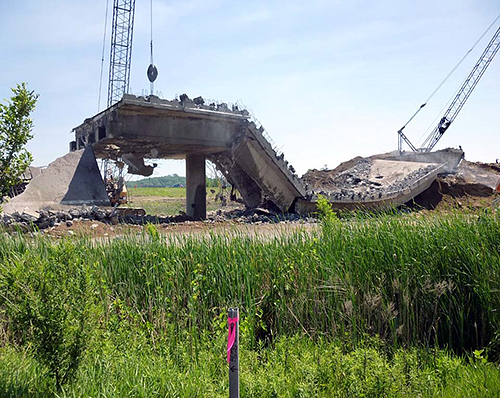Assessment guidelines

Prior to demolition or relocation of a structure, an asbestos containing material and regulated materials assessment must be performed by a MnDOT Certified Contractors (Prequalified Contractor, 19.1 PDF) and an assessment report prepared documenting the findings. The assessment should include the entire parcel and not just the structure. Regulated materials, such as treated wood (used for landscaping) can be present at the project site that are not associated with the structure. The assessment report must adhere to MnDOT report requirements below:
- Identify the presence of asbestos and regulated materials. The report must describe the structure and include the type, location and amount of each regulated material found in the structure and on the parcel.
- The assessment must be completed by an asbestos inspector certified with the Minnesota Department of Health and under the direction of a certified hazardous material manager.
The term Regulated Materials includes products and waste materials that are regulated by federal or state agencies and must be addressed in the assessment report. Regulated wastes include, but are not limited to the following examples:
- Chlorofluorocarbons (CFC’s) – from heat pumps and central air conditioners.
- Polychlorinated Biphenyls (PCB’s) – from caulk, light ballasts and electronic relays.
- Mercury – from fluorescent lighting, electrical switches and thermostats.
- Lead – from loose paint, gaskets, circuit boards, piping and batteries.
- Treated Wood, including subsurface pilings (creosote, pentachlorophenol, CCA or other types of wood treatment).
- White Goods – e.g. stoves, ovens, refrigerators and washing machines.
- Electronics – e.g. televisions, smoke alarms, computers and printers.
- Other household hazardous wastes on the premises - e.g. waste paints, pesticides and solvents.
Investigate for and document presence and location of any features that may contain regulated material. Examples of these features include, but are not limited to:
- Flammable waste traps which may contain oily sediment.
- Above ground and underground storage tanks which may contain fuel, sludge or other chemicals.
- Hydraulic hoists which may contain hydraulic fluid.
- Sumps which may contain oily wastes and other chemicals.
- Septic systems which may contain human waste and other chemicals.
Assessment report requirements
Proper documentation of the assessment is necessary to meet federal and state regulations and MnDOT requirements. Information in the assessment report is critical for the abatement process when regulated materials are removed from the structure or the parcel. The assessment report must document the presence of asbestos containing materials, other regulated materials and any features that may contain regulated materials.
The assessment report should be prepared in general conformance with one of the following templates:
The assessment report must provide the following information:
- Signature, date and certification number of Minnesota Department of Health certified asbestos inspector who performed the assessment;
- Signature, date and certification number of Certified Hazardous Material Manager who oversaw the assessment;
- Copies of the current MDH certified asbestos inspector license and MDH hard card photo identification for each inspector who performed the assessment;
- Copy of CHMM certification of individual providing assessment oversight;
- Written certification that the assessment was performed in compliance with Minnesota Rules Chapter 4620;
- Location of the structure. Include as appropriate the street address, parcel number, bridge number, state project number (SP) and trunk highway designation;
- Summary of ACM and regulated material discovered and action required for proper management before demolition, renovation, or relocation of the structure;
- Structure sketch or photo that includes detailed locations of each homogenous area and sampling point of material known or suspected to contain asbestos;
- Condition of each homogenous area of material known to contain asbestos;
- Total quantity of friable, Category I and Category II ACM in each structure;
- Detailed information of regulated materials discovered and any sampling completed;
- Spreadsheet identifying the presence, or absence of other regulated materials included in the spreadsheet in the report template. For materials that are present, provide the total quantity and location in the structure or on the parcel;
- Laboratory chain of custody forms and laboratory results for any regulated or suspect material sampled.
- All samples must be analyzed by a laboratory with at least one of the following active accreditations or successful participation in one of the following programs:
- Accredited by the National Institute of Standards and Technology Program
- Accredited by the National Voluntary Laboratory Accreditation Program
- Successful participation in the asbestos bulk analysis program of the American Industrial Hygiene Association

